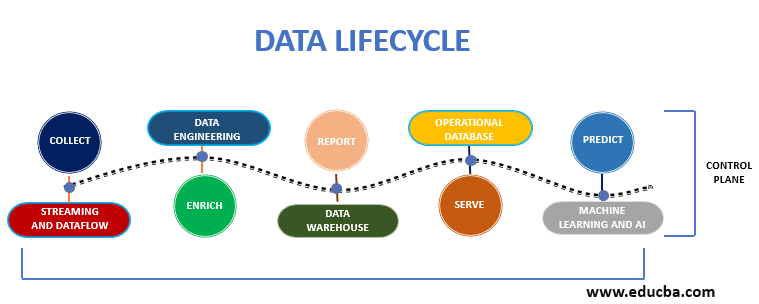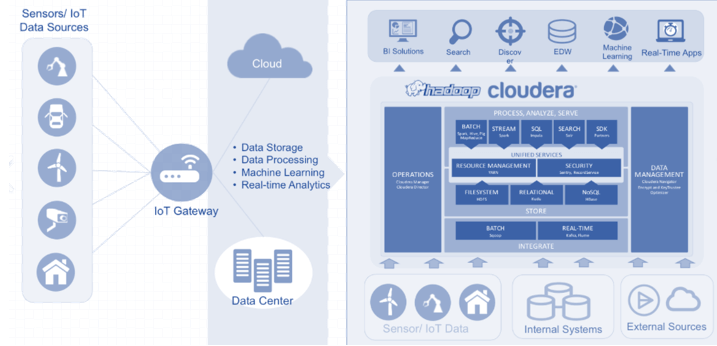Updated March 13, 2023

Introduction to Cloudera
The following article provides an outline for Cloudera Architecture. Cloudera is a big data platform where it is integrated with Apache Hadoop so that data movement is avoided by bringing various users into one stream of data. Data discovery and data management are done by the platform itself to not worry about the same. Also, the security with high availability and fault tolerance makes Cloudera attractive for users. As this is open source, clients can use the technology for free and keep the data secure in Cloudera. We can use Cloudera for both IT and business as there are multiple functionalities in this platform.
Architecture of Cloudera
Given below is the architecture of Cloudera:
1. Simplicity of Cloudera and its security during all stages of design makes customers choose this platform. In addition, Cloudera follows the new way of thinking with novel methods in enterprise software and data platforms.
2. While other platforms integrate data science work along with their data engineering aspects, Cloudera has its own Data science bench to develop different models and do the analysis. As Apache Hadoop is integrated into Cloudera, open-source languages along with Hadoop helps data scientists in production deployments and projects monitoring.
3. We have private, public and hybrid clouds in the Cloudera platform. The components of Cloudera include Data hub, data engineering, data flow, data warehouse, database and machine learning.
4. Data lifecycle or data flow in Cloudera involves different steps. The first step involves data collection or data ingestion from any source. The next step is data engineering, where the data is cleaned, and different data manipulation steps are done. After this data analysis, a data report is made with the help of a data warehouse. This report involves data visualization as well. This data can be seen and can be used with the help of a database. This is the fourth step, and the final stage involves the prediction of this data by data scientists. This prediction analysis can be used for machine learning and AI modelling.
5. The data sources can be sensors or any IoT devices that remain external to the Cloudera platform. Also, data visualization can be done with Business Intelligence tools such as Power BI or Tableau. These tools are also external. Data from sources can be batch or real-time data. The database user can be NoSQL or any relational database.
6. Data hub provides Platform as a Service offering to the user where the data is stored with both complex and simple workloads. Any complex workload can be simplified easily as it is connected to various types of data clusters. We can see that whether the same cluster is used anywhere and how many servers are linked to the data hub cluster by clicking on the same. If the workload for the same cluster is more, rather than creating a new cluster, we can increase the number of nodes in the same cluster. The nodes can be computed, master or worker nodes. Also, cost-cutting can be done by reducing the number of nodes.
7. To provide security to clusters, we have a perimeter, access, visibility and data security in Cloudera. Cluster entry is protected with perimeter security as it looks into the authentication of users. Access security provides authorization to users. Data source and its usage is taken care of by visibility mode of security. Finally, data masking and encryption is done with data security.
8. We have dynamic resource pools in the cluster manager. Also, the resource manager in Cloudera helps in monitoring, deploying and troubleshooting the cluster. The server manager in Cloudera connects the database, different agents and APIs. It can be Rest API or any other API. Backup of data is done in the database, and it provides all the needed data to the Cloudera Manager. Agents can be workers in the manager like worker nodes in clusters so that master is the server and the architecture is a master-slave. Users can login and check the working of the Cloudera manager using API.
9. We have jobs running in clusters in Python or Scala language. While creating the job, we can schedule it daily or weekly. We can see the trend of the job and analyze it on the job runs page. Or we can use Spark UI to see the graph of the running jobs.
10. Cloudera platform made Hadoop a package so that users who are comfortable using Hadoop got along with Cloudera. Impala query engine is offered in Cloudera along with SQL to work with Hadoop. Many open source components are also offered in Cloudera, such as Apache, Python, Scala, etc.
11. In the quick start of Cloudera, we have the status of Cloudera jobs, instances of Cloudera clusters, different commands to be used, the configuration of Cloudera and the charts of the jobs running in Cloudera, along with virtual machine details.
12. Various clusters are offered in Cloudera, such as HBase, HDFS, Hue, Hive, Impala, Spark, etc. The most used and preferred cluster is Spark. As explained before, the hosts can be YARN applications or Impala queries, and a dynamic resource manager is allocated to the system. Static service pools can also be configured and used.
13. Hadoop is used in Cloudera as it can be used as an input-output platform. So even if the hard drive is limited for data usage, Hadoop can counter the limitations and manage the data. Instead of Hadoop, if there are more drives, network performance will be affected.
14. Fastest CPUs should be allocated with Cloudera as the need to increase the data, and its analysis improves over time. Bottlenecks should not happen anywhere in the data engineering stage.
15. Only the Linux system supports Cloudera as of now, and hence, Cloudera can be used only with VMs in other systems.
Conclusion – Cloudera Architecture
Cloudera is the first cloud platform to offer enterprise data services in the cloud itself, and it has a great future to grow in today’s competitive world. All the advanced big data offerings are present in Cloudera.
Recommended Articles
This is a guide to Cloudera Architecture. Here we discuss the introduction and architecture of Cloudera for better understanding. You may also have a look at the following articles to learn more –



